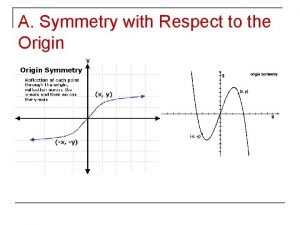A Symmetry with Respect to the Origin Symmetry
















- Slides: 16

A. Symmetry with Respect to the Origin

Symmetry with respect to the n A function has a graph that is symmetric origin n with respect to the origin if and only if f(-x) = -f(x) for all x in the domain of f. A graph will have symmetry about the origin if we get an equivalent equation when all the y’s are replaced with -y and all the x’s are replaced with -x. So for every point (x, y) on the graph, the point (-x, -y) is also on the graph. It is a reflection about both the x- and yaxis.

Ex 1 Is each graph symmetric with respect to the origin? How do you The graph does not appear to be symmetric with respect to the origin. We can verify this algebraically by the know? following two-step method: Step 1: find f(-x) and –f(x) Step 2: if f(-x) = -f(x), then the graph has symmetry about the origin. If not, then it is not. If you have an equation instead of a function, you can: Step 1: Replace all x’s with –x and all y’s with –y. Step 2: if you get the same equation, then it is equivalent about the origin. ≠ No, f(x) = x 6 is not symmetric with respect to the origin.

Ex 1 Is each graph symmetric with respect to the origin? How do you The graph appears to be know? symmetric about the origin, but lets check algebraically. Remember the two steps: Step 1: find f(-x) and –f(x) Step 2: if f(-x) = -f(x), then the graph has symmetry about the origin. If not, then it is not. =

B. Line symmetry n Two points P and P’ are symmetric with respect to a line l if and only if l is the perpendicular bisector of A point P is symmetric to itself with respect to line l if and only if P is on l. n Graphs that have line symmetry can be folded along the line of symmetry so that the two halves match exactly. Some graphs, such as the graph of an ellipse, have more than one line of symmetry. n Common lines of symmetry: x-axis, y = x and y = -x.



Ex 2: Determine whether the graph of x 2 + y = 3 is symmetric with respect to the x-axis, y-axis, the line y = x, the line y = -x, or none of Answer: y-axis these. You can figure this out without actually graphing the equation. Here is how: Symmetry with respect to the line: Test Results x-axis (a, b) and (a, -b) should produce equivalent equations. x 2 + y = 3 a 2 + b = 3 a 2 - b = 3 No, these are not equivalent equations, so it is not symmetric with respect to the x-axis. y-axis (a, b) and (-a, b) should produce equivalent equations. x 2 + y = 3 a 2 + b = 3 Yes, these are equivalent equations, so it is symmetric with respect to the y-axis. y = x (a, b) and (b, a) should produce equivalent equations. x 2 + y = 3 a 2 + b = 3 b 2 + a = 3 No, these are not equivalent equations, so it is not symmetric with respect to the line y = x. y = -x (a, b) and (-b, -a) should produce equivalent equations. x 2 + y = 3 a 2 + b = 3 b 2 - a = 3 No, these are not equivalent equations, so it is not symmetric with respect to the line y = -x.

Test both: Symmetry with respect to the line: Test Results x-axis Yes, these are equivalent equations, so it is symmetric with respect to the x-axis. y-axis Yes, this are equivalent equations, so it is symmetric with respect to the y-axis. Answer: Both

II. Even, Odd, or Neither Functions n Not to be confused with End Behavior To determine End Behavior, we check to see if the leading degree is even or odd n With Functions, we are determining SYMMETRY (if the entire function is even, odd, or neither) n

A. Symmetric with respect to the y-axis Symmetric with respect to the origin To determine whether a function is even, odd, or neither, determine whether f(-x) = f(x) (even), f(-x) = -f(x) (odd), or neither.

Ex. 1 Even, Odd or Neither? Graphically Algebraically

Ex. 2 Even, Odd or Neither? Graphically Algebraically f(-x)=(-x)2+1 f(-x)=x 2+1

Ex. 3 Even, Odd or Neither? Graphically Algebraically f(-x) = (-x)3 -1 f(-x) = -x 3 -1

Ex. 4 Even, Odd or Neither?

B. Copy and complete the graph so that it is an even function and then an odd function. Even: symmetric about the y-axis Odd: Symmetric about the origin
 Symmetric points on a graph
Symmetric points on a graph Origin symmetry examples
Origin symmetry examples Từ ngữ thể hiện lòng nhân hậu
Từ ngữ thể hiện lòng nhân hậu Trời xanh đây là của chúng ta thể thơ
Trời xanh đây là của chúng ta thể thơ Tư thế ngồi viết
Tư thế ngồi viết V cc
V cc Voi kéo gỗ như thế nào
Voi kéo gỗ như thế nào Thơ thất ngôn tứ tuyệt đường luật
Thơ thất ngôn tứ tuyệt đường luật Sự nuôi và dạy con của hổ
Sự nuôi và dạy con của hổ Thế nào là hệ số cao nhất
Thế nào là hệ số cao nhất Diễn thế sinh thái là
Diễn thế sinh thái là đại từ thay thế
đại từ thay thế Frameset trong html5
Frameset trong html5 Vẽ hình chiếu vuông góc của vật thể sau
Vẽ hình chiếu vuông góc của vật thể sau 101012 bằng
101012 bằng Thế nào là mạng điện lắp đặt kiểu nổi
Thế nào là mạng điện lắp đặt kiểu nổi Mật thư anh em như thể tay chân
Mật thư anh em như thể tay chân































